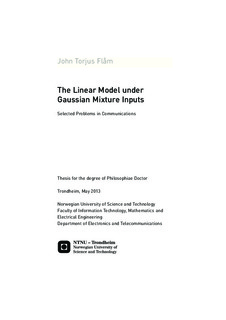| dc.contributor.author | Flåm, John Torjus | nb_NO |
| dc.date.accessioned | 2014-12-19T13:48:26Z | |
| dc.date.accessioned | 2015-12-22T11:48:03Z | |
| dc.date.available | 2014-12-19T13:48:26Z | |
| dc.date.available | 2015-12-22T11:48:03Z | |
| dc.date.created | 2013-07-25 | nb_NO |
| dc.date.issued | 2013 | nb_NO |
| dc.identifier | 638099 | nb_NO |
| dc.identifier.isbn | 978-82-471-4421-3 (printed ver.) | nb_NO |
| dc.identifier.isbn | 978-82-471-4422-0 (electronic ver.) | |
| dc.identifier.uri | http://hdl.handle.net/11250/2370728 | |
| dc.description.abstract | Consider a linear model, y = Hx + n, where y is an observed vector, H is a known matrix, x is the unknown vector of interest, and n is noise. Such a linear model can describe, or approximate, a multitude of systems.
In this thesis, it is assumed that x and n are distributed as independent Gaussian mixtures (GM). Besides their ability to approximate other distributions, Gaussian mixtures can account for asymmetry, heavy tails and/or multi modality. They can in principle model any random variable, and therefore Gaussian mixtures provide great realism.
Assuming mixed Gaussian inputs, we study problems related to the minimum mean square error (MMSE) when estimating x from the observation y. Characterizing or manipulating the MMSE is non-trivial, mainly for the following reason. In the special case when both x and n are purely Gaussian inputs, then both the MMSE estimator and the MMSE have analytical, closed form expressions. In the more general case, however, when one or both of the inputs are multi-component Gaussian mixtures, then the MMSE estimator remains analytical, but the MMSE does not. The implication is that the optimal estimator can be implemented, but its performance cannot be exactly characterized.
One consequence, is that implementing MMSE reducing measures becomes a quite difficult task. For example, again in the purely Gaussian setting, an MMSE reducing linear precoder can be derived as the solution of a convex program. When inputs are Gaussian mixtures, however, this task is much more difficult. Then the problem not only turns non-convex, but the objective function (the MMSE) takes the form of a non-analytical integral.
Among the contributions of the thesis, two important ones can be summarized as follows: (i) We bound the MMSE, both from above and below, by analytical expressions. We also show that these bounds approach each other with increasing signal to noise ratio (SNR). Therefore, from moderate to high SNR, the MMSE can be bracketed rather accurately. (ii)We describe a procedure for designing the matrixH, so as to minimize MMSE. This design problem is motivated by two applications in signal processing. One concerns the design of error-reducing precoders; the other deals with selection of pilot signals for channel estimation. | nb_NO |
| dc.language | eng | nb_NO |
| dc.publisher | Norges teknisk-naturvitenskapelige universitet, Fakultet for informasjonsteknologi, matematikk og elektroteknikk, Institutt for elektronikk og telekommunikasjon | nb_NO |
| dc.relation.ispartofseries | Doktoravhandlinger ved NTNU, 1503-8181; 2013:157 | nb_NO |
| dc.relation.haspart | Flam, John T.; Jalden, Joakim; Chatterjee, Saikat. GAUSSIAN MIXTURE MODELING FOR SOURCE LOCALIZATION. 2011 IEEE INTERNATIONAL CONFERENCE ON ACOUSTICS, SPEECH, AND SIGNAL PROCESSING: 2604-2607, 2011. <a href='http://dx.doi.org/10.1109/ICASSP.2011.5947018'>10.1109/ICASSP.2011.5947018</a>. | nb_NO |
| dc.relation.haspart | Flam, John T.; Chatterjee, Saikat; Kansanen, Kimmo; Ekman, Torbjorn. On MMSE Estimation. IEEE Transactions on Signal Processing. (ISSN 1053-587X). 60(7): 3840-3845, 2012. <a href='http://dx.doi.org/10.1109/TSP.2012.2192112'>10.1109/TSP.2012.2192112</a>. | |
| dc.relation.haspart | Flåm, John T.; Zachariah, Dave; Vehkaperä, Mikko; Chatterjee, Saikat. The Linear Model under Mixed Gaussian Inputs: Designing the Transfer Matrix. | |
| dc.relation.haspart | Flåm, J.T.; Björnson, E.; Chatterjee, S.. Pilot Design for MIMO channel estimation: An Alternative to the Kronecker Structure Assumption. Accepted for IEEE International Conference on Acoustics, Speech and Signal Processing (ICASSP) 2013, 2013. | |
| dc.title | The Linear Model under Gaussian Mixture Inputs: Selected Problems in Communications | nb_NO |
| dc.type | Doctoral thesis | nb_NO |
| dc.contributor.department | Norges teknisk-naturvitenskapelige universitet, Fakultet for informasjonsteknologi, matematikk og elektroteknikk, Institutt for elektronikk og telekommunikasjon | nb_NO |
| dc.description.degree | PhD i elektronikk og telekommunikasjon | nb_NO |
| dc.description.degree | PhD in Electronics and Telecommunication | |
